Mixing Vintage and Modern Decor for an Eclectic Home
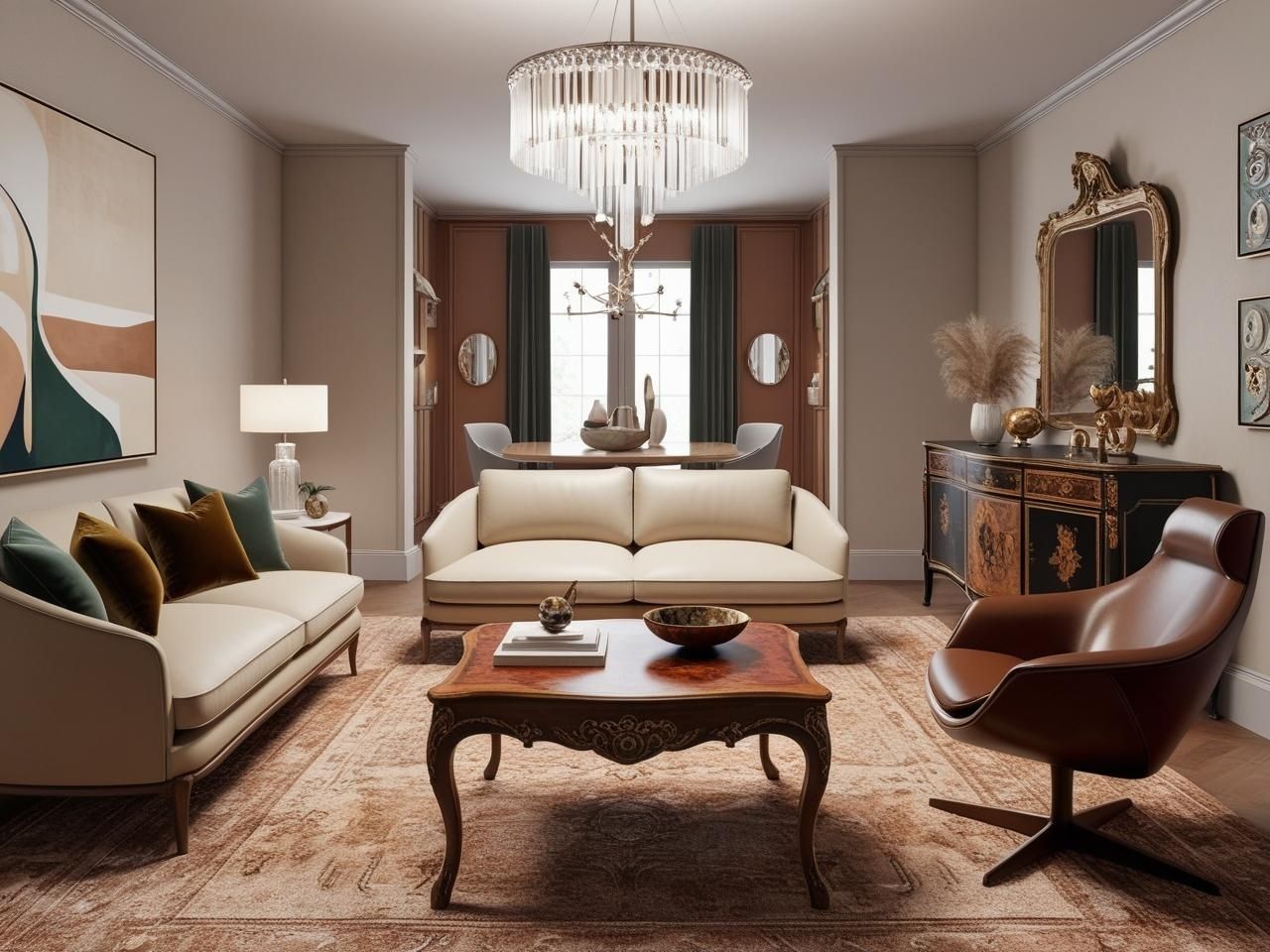
You know that moment when you’re standing in your living room, surrounded by pieces you absolutely love individually, but something’s just… not quite clicking? Maybe it’s that gorgeous vintage credenza you inherited sitting awkwardly next to your sleek modern sofa, or that amazing mid-century chair that somehow feels like it’s crashed the wrong party in your contemporary space.
Trust me, I’ve been there! After years of what I like to call “design dating” – trying to match up pieces from different eras and styles – I’ve learned that mixing vintage and modern elements is a lot like creating the perfect dinner party. It’s not about having everyone be exactly the same; it’s about creating conversations and connections that make the whole experience more interesting.
Remember the first time you realized you could love both that ornate antique mirror AND that minimalist coffee table? That’s the magic we’re going to explore together. Whether you’re staring at a beloved family heirloom wondering how to make it play nice with your contemporary pieces, or you’re eyeing that perfect vintage find but worried it might throw off your modern vibe, I’ve got you covered.
What I love most about blending vintage and modern pieces is that there’s no strict rulebook – just guidelines that help you create a space that feels thoughtfully curated rather than randomly assembled. Through plenty of trial and error (and yes, a few design choices I still laugh about), I’ve discovered some game-changing ways to make these seemingly opposite styles not just coexist, but actually enhance each other.
Ready to discover how to create a space that tells your unique story while looking absolutely amazing? Let’s dive into the art of mixing vintage and modern pieces – and trust me, by the end of this, you’ll never look at your great-aunt’s side table the same way again!
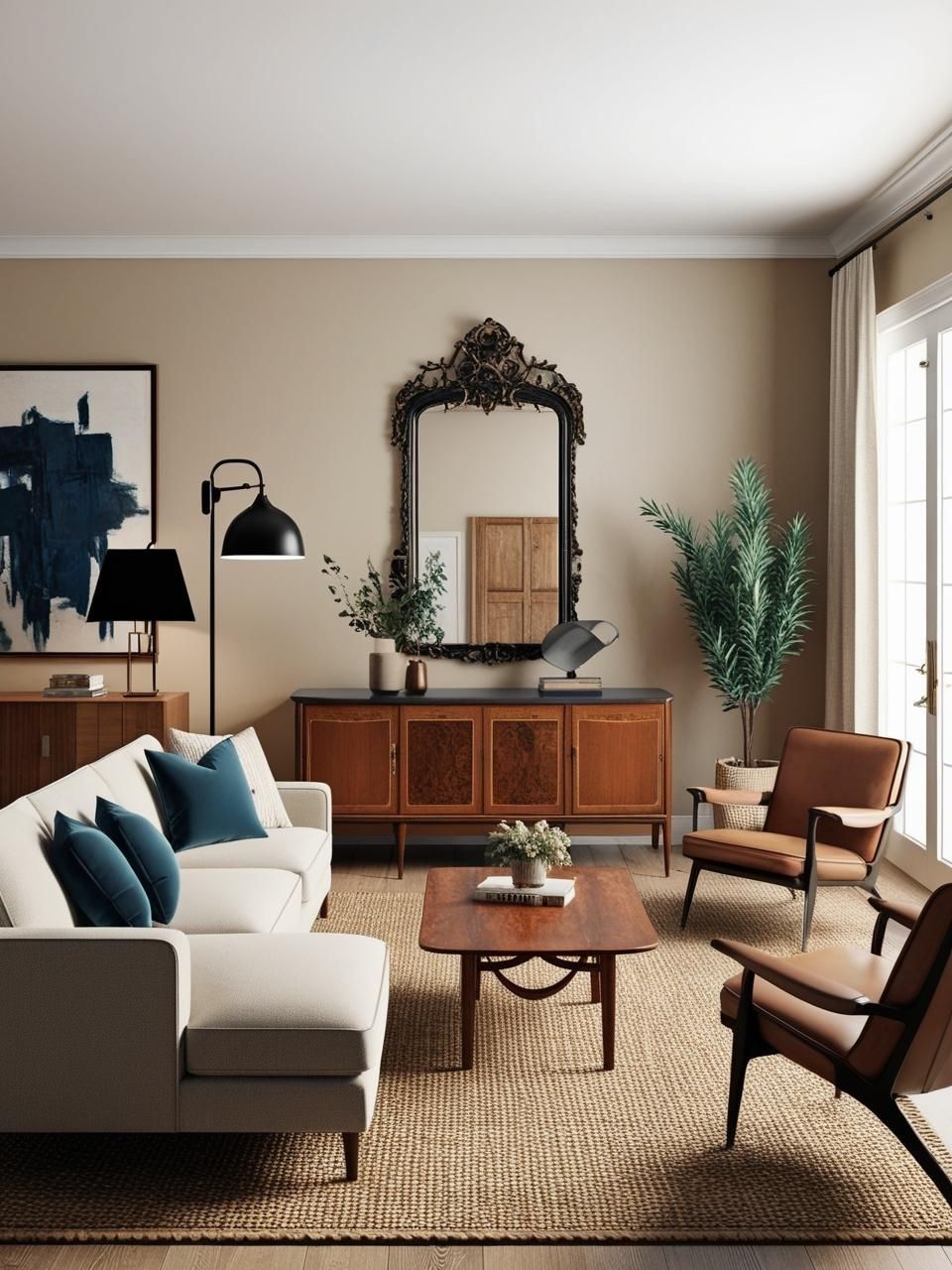
Why Mixing Vintage and Modern Pieces Creates a Timeless Look
You know that feeling when you walk into a room and it just feels right? Not perfectly matched or straight-out-of-a-catalog perfect, but authentically beautiful in a way that makes you want to sink into the nearest chair and stay awhile. That’s the magic that happens when vintage and modern pieces come together thoughtfully.
The Art of Storytelling Through Design
Think of your space as a conversation between different eras. That weathered leather armchair you found at an estate sale isn’t just competing with your sleek modern sofa – they’re actually complementing each other, each piece adding its own voice to your home’s story. When you mix periods and styles, you’re creating layers of interest that no single-era room could achieve.
The best part? These combinations actually prevent your space from feeling dated. While strictly contemporary rooms can start feeling like time capsules of a particular year, and all-vintage spaces might veer into “grandma’s attic” territory, thoughtfully mixed spaces have this wonderful way of feeling both current and timeless.
Finding Your Perfect Balance
Here’s what makes this approach so special: it’s entirely yours. Maybe it’s the way your grandmother’s brass mirror catches the light from that architectural floor lamp you splurged on last year. Or how that mid-century credenza creates the perfect foundation for your collection of contemporary ceramics. These juxtapositions create visual excitement while adding depth to your space.
The emotional resonance of vintage pieces adds something that brand-new items simply can’t replicate. Each scratch and patina marks a moment in time, bringing character and soul to balance out the crisp lines and perfect finishes of modern design. It’s like having a historian and a contemporary artist collaborating on your space.
Creating Connection Through Contrast
One of the most fascinating aspects of mixing old and new is how it reflects real life. None of us exist in just one era or style – we’re all products of different influences and experiences. When your space reflects this natural blend, it becomes more than just a well-designed room; it becomes a genuine expression of who you are.
Remember, there’s no rule that says your Danish modern dining table can’t play nice with those ornate vintage dining chairs. In fact, these unexpected combinations often become the most interesting focal points in a room. They create conversation, spark joy, and most importantly, make your space feel alive with personality.
The key isn’t about following strict design rules – it’s about creating a space that feels authentic to you while honoring both the past and present. When you get it right, you’ll know. It’s that feeling when everything just clicks, and your space finally feels like home.
Your Shortcut to Effortless Quiet Luxury Style
12 refined color palettes designed to bring luxury, sophistication and harmony into your home.
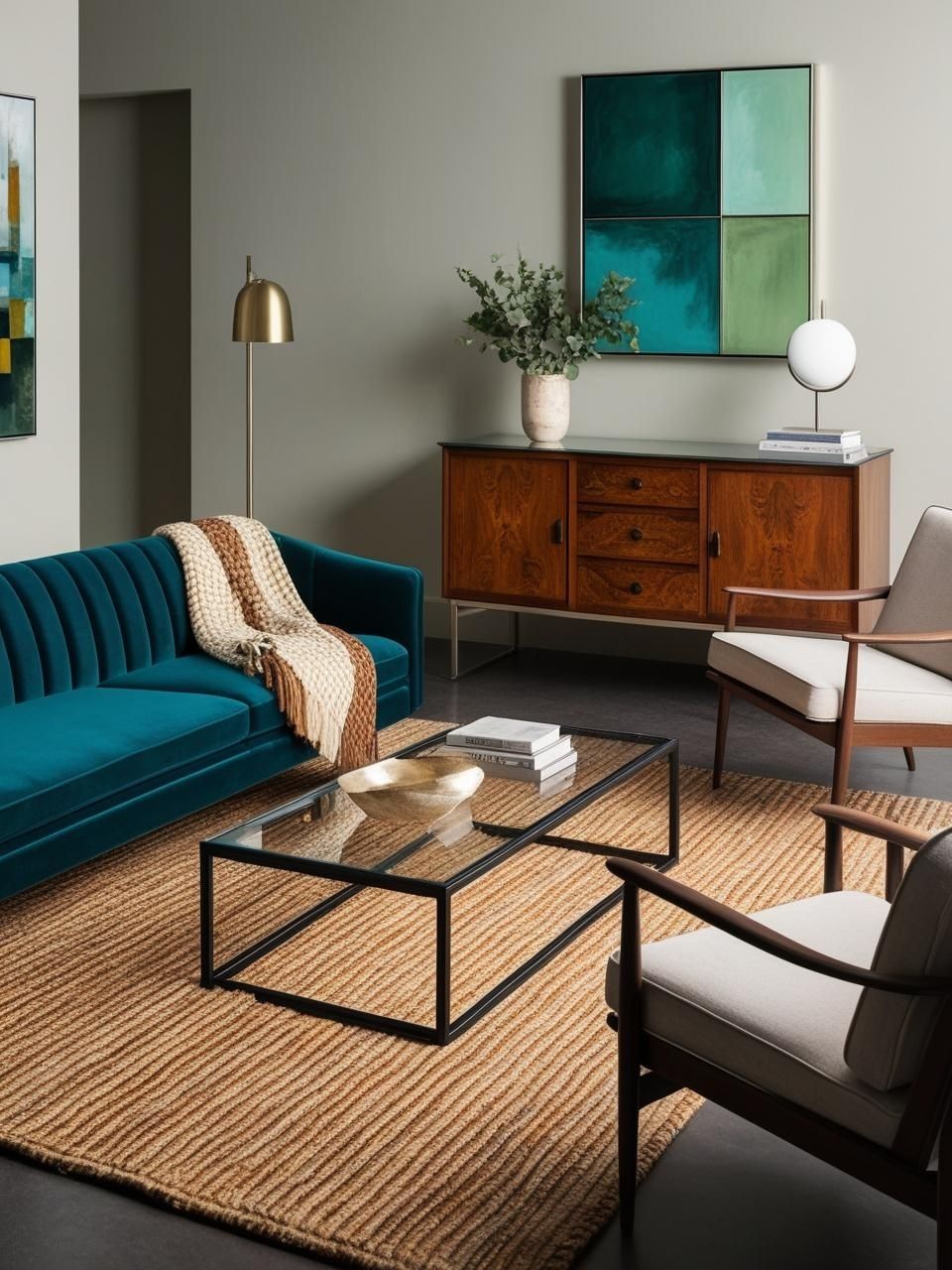
Tips for Striking the Perfect Balance Between Old and New
Let’s talk again about that moment when you’re standing in your living room, surrounded by pieces you love individually, but something’s just… off. Been there! After years of experimenting (and yes, occasionally getting it wrong), I’ve discovered some game-changing ways to make vintage and modern pieces play nicely together.
The 60/40 Rule: Your New Best Friend
Here’s a little secret I wish I’d known sooner: aim for about 60% of one style and 40% of the other. I learned this after my “everything is equal” phase resulted in what I lovingly call my “design identity crisis of 2022.” Whether you lean more vintage or modern, giving one style slightly more presence creates a more intentional look rather than a random mix.
Creating Visual Flow Through Materials
Think of materials as your design mediators. That sleek glass coffee table might seem like it’s from a different planet than your vintage wooden sideboard, but add a wooden picture frame near the table and a glass vase on the sideboard, and suddenly they’re having a conversation! It’s like introducing mutual friends at a party – everything feels more connected.
The Color Connection
Colors are your secret weapon for making different eras work together. Here’s what I’ve found works beautifully:
- Choose a consistent color palette that appears in both your vintage and modern pieces
- Use neutral-toned vintage pieces as anchors for bolder modern accents (or vice versa)
- Pull colors from vintage pieces into modern textiles or art
Remember that time I tried to match my modern blue sofa exactly to a vintage Persian rug? Spoiler: matchy-matchy isn’t the goal. Instead, look for colors that complement each other across your pieces.
Texture: The Great Unifier
One of my favorite tricks is using texture to bridge the gap between old and new. A plush modern armchair can feel right at home next to a weathered vintage trunk when you add a textured throw that picks up elements from both pieces. Think of texture as the friendly neighbor who helps everyone get along.
Scale Matters (A Lot)
After watching one too many oversized modern sofas dwarf delicate vintage side tables, I’ve learned that scale is crucial. The goal is to create conversation, not competition. Try this: step back and imagine your pieces are at a dinner party. Is anyone shouting to be heard? That’s your cue to adjust the scale.
The beauty of mixing vintage and modern pieces is that there’s no strict rulebook – just guidelines that help you create a space that feels thoughtfully curated rather than randomly assembled. And remember, if something’s not working, you can always try a different arrangement. That’s the fun part about decorating – it’s all about experimenting until you find what makes your space sing.

Finding the Right Vintage Pieces for Your Eclectic Home
Fun fact: my obsession with vintage hunting started after I stumbled into an estate sale looking for a bathroom break during a very long run. Two hours later, I emerged with a brass lamp that’s still one of my favorite pieces. Since then, I’ve learned there’s definitely an art to finding those perfect vintage pieces that play well with modern spaces.
Where the Good Stuff Hides
Let’s be real – finding great vintage pieces is kind of like dating. Sometimes you have to kiss a lot of frogs before finding your prince! Here are my tried-and-true hunting grounds:
- Estate sales (pro tip: get on local estate sale companies’ email lists for first dibs)
- Local antique markets (bonus: dealers often know their inventory’s history)
- Facebook Marketplace (yes, really – I found an amazing mid-century credenza there last month!)
- Consignment shops in upscale neighborhoods (they tend to be pickier about quality)
What to Look For (Beyond Love at First Sight)
I’ll never forget bringing home what I thought was the perfect vintage armchair, only to realize it was roughly the size of a small car. Learn from my measuring tape mishap! When hunting for vintage pieces, keep an eye out for:
- Clean lines that complement modern aesthetics (mid-century pieces are especially versatile)
- Quality materials (solid wood, genuine leather, real brass – they age like fine wine)
- Pieces with good bones but maybe not-so-good upholstery (reupholstering is your friend!)
- Items that serve a real purpose (beautiful is great, functional is essential)
The “Worth It” Assessment
Here’s something I wish someone had told me earlier: just because something’s old doesn’t mean it’s worth bringing home. Before you commit, ask yourself:
- Is the piece structurally sound? (A wobbly table is still wobbly, no matter how pretty)
- Are repairs feasible? (Sometimes “just needs a little TLC” actually means “needs a miracle”)
- Will it work with your lifestyle? (That gorgeous vintage bar cart might not be the best choice if you have toddler twins)
Giving Vintage Pieces New Life
Remember that brass lamp I mentioned? It was actually pretty tragic when I found it – wrong color, wonky shade, the works. But with some elbow grease and vision, vintage pieces can get a second chance at greatness. Consider:
- Simple refinishing for wood pieces (sometimes just oil and love is enough)
- Updated hardware for dressers and cabinets
- Modern upholstery on classic frames
- New wiring for vintage lamps (always, always get this done professionally!)
The secret to successful vintage shopping isn’t just about having a good eye – it’s about having a plan. Know what you’re looking for, where it might live in your space, and what you’re willing to take on in terms of restoration. And sometimes, the best finds happen when you least expect them… like during an emergency bathroom break!
Your Shortcut to Effortless Luxury Resort Modern Style
12 refined color palettes designed to bring luxury, sophistication and harmony into your home.
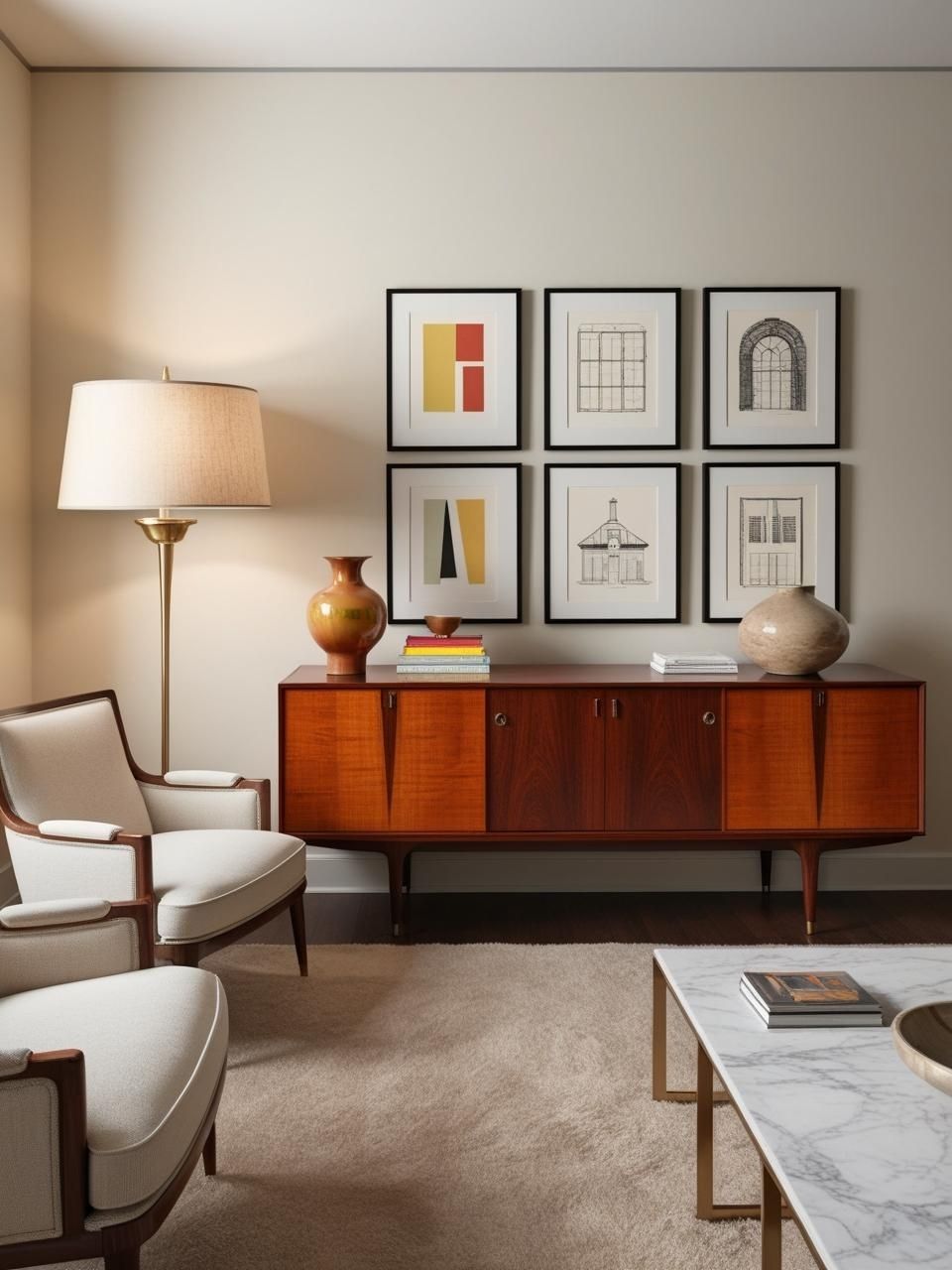
Adding Modern Flair to Vintage Designs
Picture this: I’m standing in my living room, staring at my grandmother’s gorgeous mahogany secretary desk, wondering how on earth to make it work with my love for clean lines and contemporary design. Fast forward through some trial and error (okay, mostly error at first), and I’ve discovered that modern touches can actually make vintage pieces shine even brighter.
Lighting: The Game Changer
Let me tell you about my favorite design “aha” moment. I’d been struggling with a beautiful vintage credenza that felt a bit… well, stuck in the past. Then I paired it with a sleek, modern arc lamp that practically dances over it, and suddenly – magic! It’s like the lamp is saying, “Hey, check out my cool vintage friend here!”
Modern lighting can transform vintage pieces in surprising ways:
- Minimalist sconces flanking a vintage mirror
- A contemporary pendant light hanging over an antique dining table
- Sleek task lighting on a vintage desk
The Art of Modern Accessories
Here’s a little secret: modern art and vintage furniture are like unexpected best friends. That abstract canvas you love? It’ll make your vintage cabinet look collected rather than inherited. I learned this after nearly giving up on a vintage console that felt too traditional – until I hung a bold, contemporary piece above it. Instant transformation!
Playing with Pattern and Color
Remember when we all thought vintage pieces had to live with vintage-inspired colors? Yeah, let’s forget that rule. Some of my favorite combinations came from breaking it:
- A Victorian settee reupholstered in a modern geometric print
- Traditional chairs painted in contemporary colors (that dark teal vintage chair in my office still makes me smile)
- Modern, solid-colored pillows on detailed vintage furniture
The Technology Blend
Let’s talk about something we all face – making room for modern life in vintage pieces. That vintage cabinet you love? With a few careful modifications, it could become the most interesting media center on the block. I’ve seen a beautiful art deco cabinet transformed into a charging station that actually makes people want to look at their tangle of cords.
Finishing Touches
The real magic happens in the details. Modern metallics can give vintage pieces new life – just be intentional about it (unlike my three-different-gold-finishes phase). A sleek brass lamp, contemporary silver picture frames, or matte black hardware can create a beautiful bridge between old and new.
Remember, adding modern elements to vintage pieces isn’t about overshadowing their character – it’s about highlighting it in a fresh way. Think of it as giving your vintage pieces some cool new friends who make them look even better. And if something doesn’t work? Well, that’s what rearranging is for!
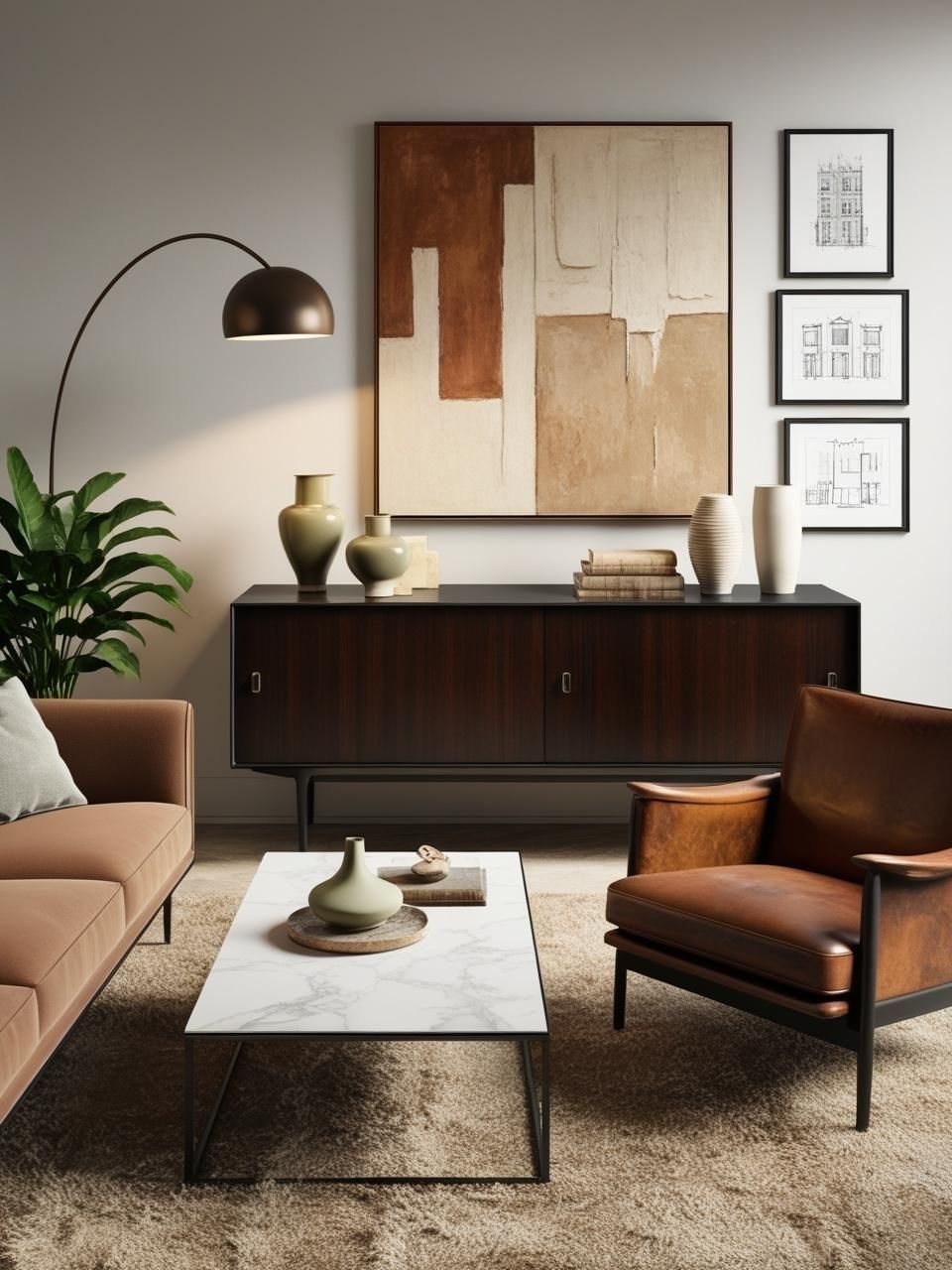
Creating a Cohesive Style: Color, Texture, and Layout
Remember that time you tried putting together an outfit and everything matched perfectly on paper, but something still felt off? That’s exactly what happened in my living room once. I had all these gorgeous pieces that I loved individually, but together they were like a party where nobody was talking to each other. Then I discovered the secret sauce: it’s all about color, texture, and thoughtful placement.
The Color Connection
Here’s a confession: I used to think “neutral” meant boring. Plot twist – it actually means powerful! Think of a neutral base as the perfect host at your furniture party, making sure everyone plays nice together. I’ve found this approach works wonders:
- Start with a foundation of versatile neutrals (grays, tans, whites)
- Add two or three accent colors that appear in both your vintage and modern pieces
- Use these accent colors intentionally throughout the space – maybe it’s the blue in your vintage rug picking up the blue in your modern art piece
Texture: Your Secret Weapon
Let me tell you about my favorite design breakthrough: mixing textures is like adding dimension to a photograph. It takes your space from flat to fascinating. In my own home, I’ve learned to layer:
- Smooth modern glass with rough vintage wood
- Sleek metal against plush vintage upholstery
- Woven textiles draped over clean-lined furniture
When everything has different tactile qualities, your eye naturally moves around the room, creating that lived-in, collected-over-time feeling we’re all after.
The Layout Logic
Full disclosure: I rearranged my living room seven times before I cracked the code on furniture placement. Here’s what finally worked:
- Create conversation areas where vintage and modern pieces can mingle naturally
- Allow for negative space – not every inch needs to be filled
- Position larger pieces (like that amazing vintage sofa) first, then build around them
- Use rugs to define spaces and ground different style groupings
The Flow Factor
Think of your room layout like a good playlist – it needs to flow! I learned this after creating what I lovingly called my “obstacle course era” of furniture arrangement. Now I make sure to:
- Keep main pathways clear and intuitive
- Balance heavy pieces throughout the space
- Create natural pauses where the eye can rest
- Position contrasting pieces where they can complement rather than compete
The best part about getting these elements right? Your space will feel intentional rather than accidental. And remember, if something’s not working, you can always switch it up. After all, even the best playlists need updating sometimes!
Unlock Designer-Perfect Colors in Minutes
Browse my curated collection of interior color palettes—tailored for today’s most loved design styles.
Common Mistakes to Avoid When Mixing Vintage and Modern Pieces
Let me tell you about the time I created what I now affectionately call my “museum of misfit furniture.” Picture this: a massive vintage armoire towering over a delicate modern sofa, three different design styles fighting for attention, and enough mixed metals to start a hardware store. We’ve all been there! Let’s talk about the most common mixing mishaps and how to avoid them.
The “Everything Is Special” Syndrome
You know that feeling when you love every piece so much that you want to display them all? Been there! My living room once looked like a design sample sale because I couldn’t bear to edit. Here’s what I learned:
- Choose your statement pieces wisely (not everything can be the star of the show)
- Give your special pieces breathing room
- Remember that some beautiful things can wait for their moment in a different season
The Scale Struggle
True story: I once paired a dainty vintage side table with a chunky modern sectional. The table looked like it was playing dress-up in adult furniture! Scale issues are like bad blind dates – awkward and immediately obvious. Here’s how to avoid them:
- Match the visual weight of your pieces (even if their styles differ)
- Consider the height relationships between furniture
- Think about how pieces look from every angle (my “perfect” vintage chair looked terribly out of place from the side)
The Color Chaos Conundrum
Remember when I mentioned my three-different-golds phase? Well, that was just the tip of the iceberg. I once convinced myself that “everything goes with blue” – narrator: it did not. Here’s what actually works:
- Stick to a defined color palette
- Use color to create intentional connections between pieces
- Don’t force color matches – if you have to squint to see the similarity, it’s probably not there
The “But It’s Vintage!” Trap
Oh, this one’s personal. I once justified keeping a massively oversized vintage cabinet because “they don’t make them like this anymore!” While that was true, it was also true that it made my dining room feel like a dollhouse. Remember:
- Just because something’s vintage doesn’t mean it’s right for your space
- Quality and age don’t override basic design principles
- Sometimes the most beautiful vintage piece belongs in someone else’s home
The Balance Blunder
Picture a seesaw with a sumo wrestler on one end and a kindergartner on the other – that’s what my first attempt at mixing styles looked like. Either the vintage pieces overwhelmed the modern ones, or vice versa. The fix?
- Create visual balance between old and new
- Distribute your statement pieces throughout the space
- Mix smaller vintage and modern accessories to create cohesion
The beauty of making these mistakes? Each one teaches you something new about your style. And hey, if you’re currently looking at your space and recognizing some of these issues – welcome to the club! We’ve all been there, and that’s exactly how we learn to create spaces that truly work.
Curated Wall Art for Elegant Homes
Bring softness, texture, and intention into your home with digital wall art inspired by wabi-sabi, abstract forms, and muted watercolors. Every piece is crafted to create stillness and beauty—whether you’re styling a gallery wall or a minimalist nook.
Creating Your Own Design Story: The Final Word
You know what’s funny? When I first started mixing vintage and modern pieces, I thought there must be some secret rulebook that all the pros were keeping under lock and key. Turns out, the real secret is that there isn’t one – and that’s actually the best part!
Here’s what I’ve learned after years of experimenting (and yes, occasionally getting it delightfully wrong): creating a space that blends vintage and modern pieces is a lot like making a really good playlist. Sure, you could stick to one genre, one decade, one mood – but where’s the fun in that? The magic happens when you start mixing things up, finding unexpected combinations that just work.
Remember what we talked about? Those vintage pieces that tell stories, the modern elements that keep things fresh, the way color and texture can make everything play nice together. It’s not about following a strict formula – it’s about trusting your instincts and being willing to experiment until you find what makes your space sing.
So here’s my challenge to you: take what resonates from these guidelines and make them your own. Maybe your perfect mix is 80% vintage with modern lighting that makes everything pop. Or perhaps you’re all about those clean contemporary lines with one showstopping vintage piece that makes everyone ask, “Where did you find that?”
The best spaces – the ones that really feel like home – are the ones that tell your unique story. They’re the ones where every piece has a purpose, whether it’s functional, beautiful, or (ideally) both. And if something’s not working? Hey, that’s what rearranging is for!
Now it’s your turn to start mixing, matching, and creating a space that’s uniquely, authentically you. Trust me, once you embrace the art of the mix, you’ll never look back. And those “mistakes” along the way? They’re just part of your design story. Who knows? Your next furniture arrangement might be your best one yet!